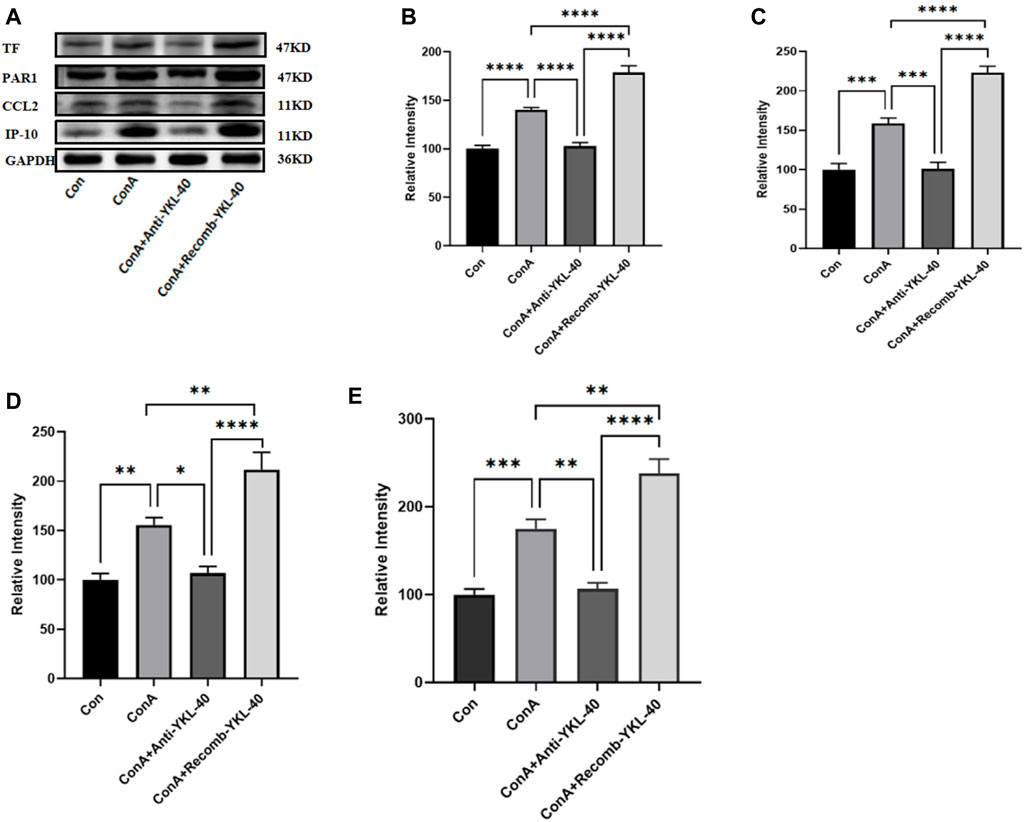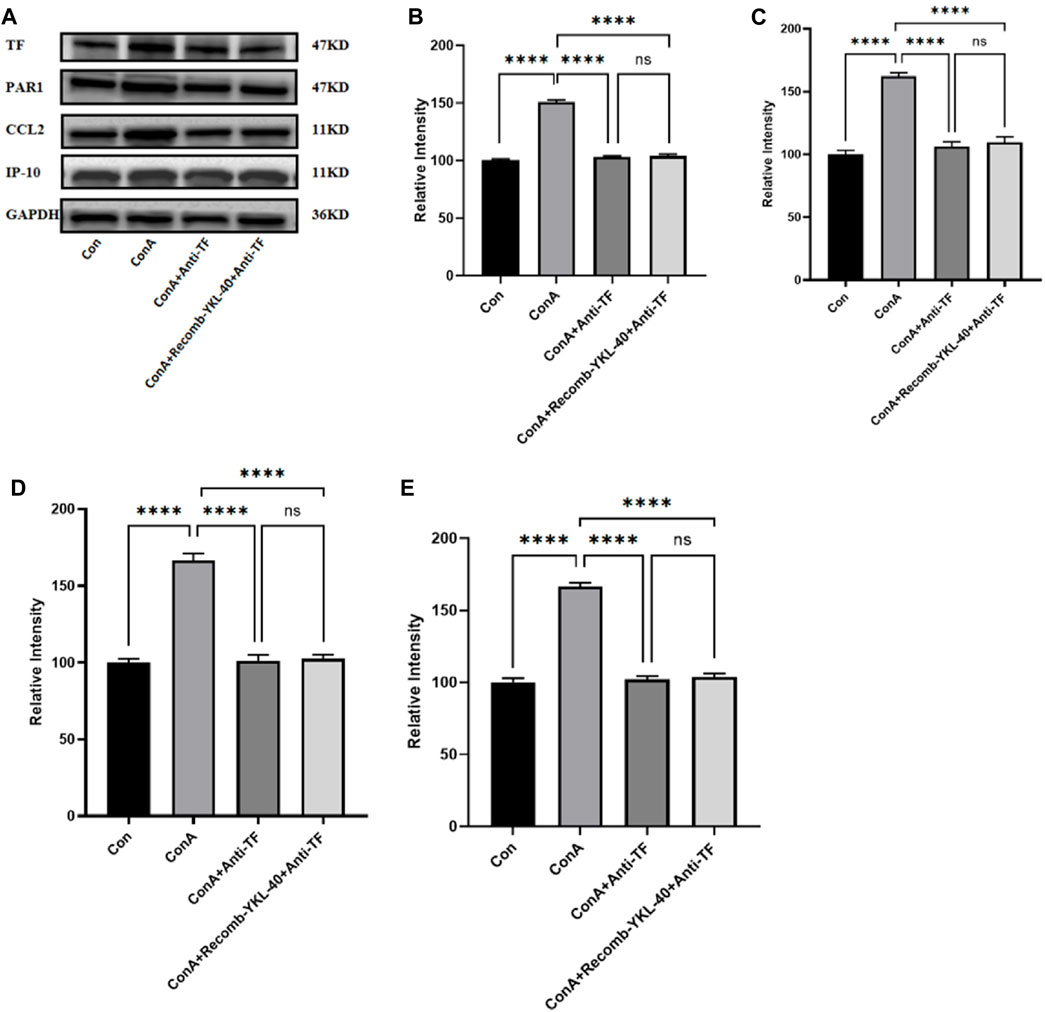- 1Department of Pharmacy, Shengjing Hospital of China Medical University, Shenyang, China
- 2Department of the Second Clinical Pharmacy, School of Pharmacy, China Medical University, Shenyang, China
A Corrigendum on
YKL-40 promotes chemokine expression following drug-induced liver injury via TF-PAR1 pathway in mice
by Jing-Lun Z, Shuang C, Li-Mei Z and Xiao-Dong L (2023). Front. Pharmacol. 14:1205062. doi: 10.3389/fphar.2023.1205062
In the published article, there was an error Figure 3A and its legend as published. The TF was inadvertently misused during the final assembly of Figure 3A. The corrected Figure 3 its caption appears below.

Figure 3. YKL-40 induces TF-PAR1 pathway and affects liver pathogenesis. (A) The levels of TF-PAR1 pathway proteins induced by YKL-40 in the liver and CCL2 and IP-10 were measured; (B) TF protein expression in mouse liver; (C) PAR1 protein expression in mouse liver; (D) CCL2 protein expression in mouse liver; (E) IP-10 protein expression in mouse liver. p values were determined using one-way ANOVA or an unpaired t-test. Data are expressed as mean ± SEM (n = 6). *p < 0.05, **p < 0.01, ***p < 0.001, ****p < 0.0001, ns means no statistical difference.
In the published article, there was an error Figure 7A and its legend as published. The TF was inadvertently misused during the final assembly of Figure 7A. The corrected Figure 7 its caption appears below.

Figure 7. Effect of blocking TF-PAR1 pathway on liver pathogenesis. After the endogenous TF protein expression was blocked, (A) the expression of TF-PAR1 pathway proteins in the liver following YKL-40 induction and the levels of downstream chemokines CCL2 and IP-10 were determined; (B) TF protein expression in mouse liver; (C) PAR1 protein expression in mouse liver; (D) CCL2 protein expression in mouse liver; (E) Expression of IP-10 protein in mouse liver. p values were determined using one-way ANOVA or an unpaired t-test. Data are expressed as mean ± SEM (n = 6). *p < 0.05, **p < 0.01, ***p < 0.001, ****p < 0.0001, ns means no statistical difference.
In the published article, there was an error. The anti-TF antibody’s manufacturer and batch number are incorrect.
A correction has been made to 2. Materials and methods, 2.1 Animal experiments, Paragraph Number 1. This sentence previously stated:
“In the experimental groups, mice were immediately injected with recombinant Chi3l1 (500 ng, Sino Biological, 50929-M08H), anti-Chi3l1 antibody (500 ng, Sino Biological, 50929-RP01), or anti-TF antibody (1/1,000, 500 μg, ProteinTech, 17435-1-AP) after receiving ConA (Shan et al., 2018).”
The corrected sentence appears below:
“In the experimental groups, mice were immediately injected with recombinant Chi3l1 (500 ng, Sino Biological, 50929-M08H), anti-Chi3l1 antibody (500 ng, Sino Biological, 50929-RP01), or anti-TF antibody (1/1,000, 500 μg, Bioss, bs-4690R) after receiving ConA (Shan et al., 2018).”
In the published article, there was an error. The anti-TF antibody’s manufacturer and batch number are incorrect.
A correction has been made to 2. Materials and methods, 2.4 Western blot analysis, Paragraph Number 1. This sentence previously stated:
“The membrane was then blocked with a rapid blocking solution and incubated with the specific primary antibodies against TF (ProteinTech, 17435-1-AP, 1/3,000), PAR1 (Solarbio, K009690P, 1/1,500), CCL2/MCP-1 (ProteinTech, 25542-1-AP, 1/2,000), and CXCL10/IP-10 (ProteinTech, 10937-1-AP, 1/500).”
The corrected sentence appears below:
“The membrane was then blocked with a rapid blocking solution and incubated with the specific primary antibodies against TF (Bioss, bs-4690R, 1/1,000), PAR1 (Solarbio, K009690P, 1/1,500), CCL2/MCP-1 (ProteinTech, 25542-1-AP, 1/2,000), and CXCL10/IP-10 (ProteinTech, 10937-1-AP, 1/500).”
The authors apologize for these errors and state that this does not change the scientific conclusions of the article in any way. The original article has been updated.
Publisher’s note
All claims expressed in this article are solely those of the authors and do not necessarily represent those of their affiliated organizations, or those of the publisher, the editors and the reviewers. Any product that may be evaluated in this article, or claim that may be made by its manufacturer, is not guaranteed or endorsed by the publisher.
Keywords: YKL-40, TF-PAR1 pathway, inflammation, liver injury, CCL2, IP-10
Citation: Jing-Lun Z, Shuang C, Li-Mei Z and Xiao-Dong L (2024) Corrigendum: YKL-40 promotes chemokine expression following drug-induced liver injury via TF-PAR1 pathway in mice. Front. Pharmacol. 15:1395496. doi: 10.3389/fphar.2024.1395496
Received: 04 March 2024; Accepted: 05 August 2024;
Published: 15 August 2024.
Edited by:
Patricia Moriel, State University of Campinas, BrazilReviewed by:
Ning Zhang, Fudan University, ChinaCopyright © 2024 Jing-Lun, Shuang, Li-Mei and Xiao-Dong. This is an open-access article distributed under the terms of the Creative Commons Attribution License (CC BY). The use, distribution or reproduction in other forums is permitted, provided the original author(s) and the copyright owner(s) are credited and that the original publication in this journal is cited, in accordance with accepted academic practice. No use, distribution or reproduction is permitted which does not comply with these terms.
*Correspondence: Liu Xiao-Dong, bGl1eGRAc2otaG9zcGl0YWwub3Jn
 Zhan Jing-Lun
Zhan Jing-Lun Chai Shuang
Chai Shuang Zhao Li-Mei1,2
Zhao Li-Mei1,2 Liu Xiao-Dong
Liu Xiao-Dong